
BIG FISH MIDWEST
Midwest Fishing At It's Finest
|
|
| | Trout Identification. |  |
| | | Author | Message |
|---|
saltfisher1
Half-Dollar


Number of posts : 8362
Age : 52
Location : Alabama/Florida Gulf coast
Registration date : 2008-02-05
 |  Subject: Trout Identification. Subject: Trout Identification.  Sat Feb 21, 2009 11:36 pm Sat Feb 21, 2009 11:36 pm | |
| Rainbow Trout The rainbow trout ( Oncorhynchus mykiss) is a species of salmonid native to tributaries of the Pacific Ocean in Asia and North America as well as much of the central, western, eastern, and especially the northern portions of the United States. The ocean going (anadromous) form (including those returning for spawning) are known as steelhead, or ocean trout (Australia). The species has been introduced for food or sport to at least 45 countries, and every continent except Antarctica. In some of these locations, such as Southern Europe, Australia and South America, they have had very serious negative impacts on upland native fish species, either by eating them, outcompeting them, transmitting contagious diseases, or hybridization with closely related species and subspecies that are native to western North America. [1][2]The species was originally named by Johann Julius Walbaum in 1792 based on type specimens from Kamchatka. Richardson named a specimen of this species Salmo gairdneri in 1836, and in 1855, W. P. Gibbons found a population and named it Salmo iridia, later corrected to Salmo irideus, however these names became deprecated once it was determined that Walbaum's type description was conspecific and therefore had precedence (see e.g. Behnke, 1966). [3] More recently, DNA studies showed rainbow trout are genetically closer to Pacific salmon ( Onchorhynchus species) than to brown trout ( Salmo trutta) or Atlantic Salmon ( Salmo salar), so the genus was changed. Unlike the species' former name's epithet iridia ( Latin: "rainbow"), the specific epithet mykiss derives from the local Kamchatkan name 'mykizha'; all of Walbaum's species names were based on Kamchatkan local names 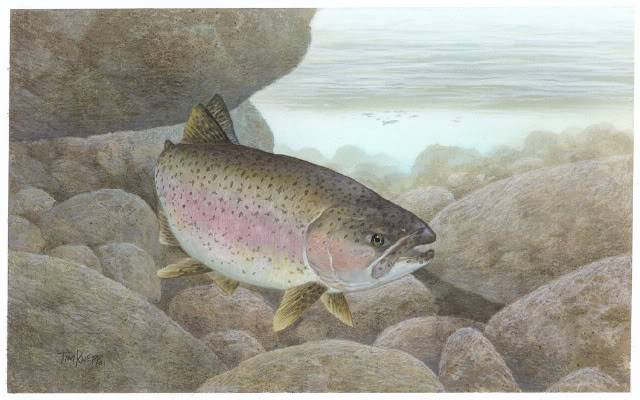
Last edited by saltfisher1 on Mon Feb 23, 2009 2:09 pm; edited 2 times in total | |
|   | | saltfisher1
Half-Dollar


Number of posts : 8362
Age : 52
Location : Alabama/Florida Gulf coast
Registration date : 2008-02-05
 |  Subject: Re: Trout Identification. Subject: Re: Trout Identification.  Sat Feb 21, 2009 11:40 pm Sat Feb 21, 2009 11:40 pm | |
| Brown Trout The brown trout ( Salmo trutta morpha fario and S. trutta morpha lacustris) and the sea trout ( S. trutta morpha trutta) are fish of the same species. They are distinguished chiefly by the fact that the brown trout is largely a freshwater fish, while the sea trout shows anadromous reproduction, migrating to the oceans for much of its life and returning to freshwater only to . [1]The lacustrine of brown trout is most usually potamodromous, migrating from lakes into rivers or streams to spawn, although there is some evidence of stocks that spawn on wind-swept shorelines of lakes. S. trutta morpha fario form stream-resident populations, typically in alpine streams but sometimes in larger rivers. There is evidence that anadromous and non-anadromous morphs coexisting in the same river can be genetically identical. [2] In common usage, the name "brown trout" is often applied indiscriminately to the various morphs. The brown trout is normally considered to be native to Europe and Asia but the natural distribution of the migratory forms may be, in fact, circumpolar. There are also landlocked populations far from the oceans, for example in Greece and Estonia. The fish is not considered to be endangered although, in some cases, individual stocks are under various degrees of stress mainly through habitat degradation, overharvest and artificial propagation leading to introgression. Predominantly in southern European regions brown trout will be affected by high water temperatures due to climate change, which will consequently affect survival rates and reproduction. In small streams brown trout is an important predator of macro-invertebrates and declining brown trout populations in these specific areas would affect the entire aquatic food web. [3]S. trutta morpha fario prefers cold (though in comparison with other trout, this species has a somewhat higher temperature preference of about 60-65 °F, or 15.5-18.3 °C), well- oxygenated upland waters, especially large streams in mountainous areas. Cover is important to trout, and they are more likely to be found where there are submerged rocks, undercut banks, and overhanging vegetation. A young brown trout from the River Derwent. The brown trout is a medium sized fish, growing to 20 kg or more in some localities although in many smaller rivers a mature weight of 1 kg (2 lb) or less is common. The current International Game Fish Association (IGFA) world "all tackle" record brown trout, 18.25 kg (40 pounds, 4 ounces), was caught in May 1992 from the Little Red River, Arkansas by Howard "Rip" Collins. [4]Brown trout may live for several years but, as with the Atlantic salmon, there is a high proportion of death of males after spawning and probably fewer than 20% of female kelts recover from spawning. The migratory forms grow to significantly larger sizes and may live longer. Brown trout are active both by day and by night and are opportunistic feeders. While in fresh water, the diet will frequently include invertebrates from the streambed, other fish, frogs, mice, birds, and insects flying near the water's surface. The high dietary reliance upon insect larvae, pupae, nymphs and adults is what allows trout to be a favoured target for fly fishing. Sea trout are especially fished for at night using wet flies. The spawning behaviour of brown trout is similar to that of the closely related Atlantic salmon. A typical female produces about 2,000 eggs per kilogram (900 eggs per pound) of body weight at spawning. Brown trout rarely form hybrids, almost invariably infertile, with other species. One such example is the tiger trout, a hybrid with the brook trout. 
Last edited by saltfisher1 on Sat Feb 21, 2009 11:53 pm; edited 1 time in total | |
|   | | saltfisher1
Half-Dollar


Number of posts : 8362
Age : 52
Location : Alabama/Florida Gulf coast
Registration date : 2008-02-05
 |  Subject: Re: Trout Identification. Subject: Re: Trout Identification.  Sat Feb 21, 2009 11:41 pm Sat Feb 21, 2009 11:41 pm | |
| Brook Trout Description Colouration: green to brown basic colouration with a distinctive marbled pattern (called vermiculations) of lighter shades across the flanks and back and extending at least to the dorsal fin, and often to the tail. There is a distinctive sprinkling of red dots, surrounded by blue haloes, along the flank. The belly and lower fins are reddish in colour, the latter with white leading edges. Often the belly, particularly of the males, becomes very red or orange when the fish are spawning. The species reaches a maximum recorded length of 86 cm (33 in) and a maximum recorded weight of 9.4 kg (14 lb). It can reach at least seven years of age, with reports of 15-year-old specimens observed in California habitats to which the species has been introduced. 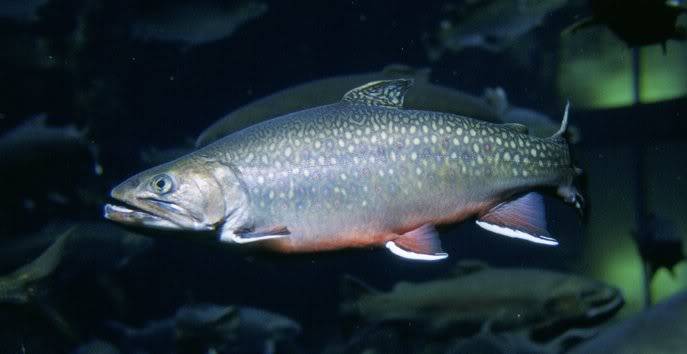
Last edited by saltfisher1 on Sat Feb 21, 2009 11:54 pm; edited 1 time in total | |
|   | | saltfisher1
Half-Dollar


Number of posts : 8362
Age : 52
Location : Alabama/Florida Gulf coast
Registration date : 2008-02-05
 |  Subject: Re: Trout Identification. Subject: Re: Trout Identification.  Sat Feb 21, 2009 11:42 pm Sat Feb 21, 2009 11:42 pm | |
| Lake Trout Lake trout ( Salvelinus namaycush) is a freshwater char living mainly in lakes in northern North America. Other names for it include mackinaw, lake char (or charr), touladi, togue, and grey trout. In Lake Superior, they can also be variously known as siscowet, paperbellies and leans. Lake trout are prized both as game fish and as food fish. Lake trout are the largest of the charrs, the record weighing almost 46.3 kg (102 lb). They were fished commercially in the Great Lakes until lampreys, overharvest and pollution extirpated or severely reduced the stocks. Commercial fisheries still exist in some smaller lakes in northern Canada. Lake trout are dependent on cold, oxygen-rich waters. They are pelagic during the period of summer stratification in dimictic lakes, often living at depths of 20–60 m (60–200 ft). The lake trout is a slowly growing fish, typical of oligotrophic waters. It is also very late to mature. Populations are extremely susceptible to overexploitation. Many native lake trout populations have been severely damaged through the combined effects of hatchery stocking (planting) and overharvest. It is generally accepted that there are two basic types of lake trout populations. Some lakes do not have pelagic forage fish during the period of summer stratification. In these lakes, lake trout take on a life history known as planktivory. Lake trout in planktivorous populations are highly abundant, grow very slowly and mature at relatively small size. In those lakes that do contain deep water forage, lake trout become piscivorous. Piscivorous lake trout grow much more quickly, mature at a larger size and are less abundant. Notwithstanding differences in abundance, the density of biomass of lake trout is fairly consistent in similar lakes, regardless of whether the lake trout populations they contain are planktivorous or piscivorous. In Lake Superior, three distinct phenotypes of lake trout persist, commonly known as "siscowet", "paperbelly" and "lean". The distinct groups operate, to some level at least, under genetic control and are not mere environmental adaptations. [1] Siscowet numbers, especially, have become greatly depressed over the years due to a combination of the extirpation of some of the fish's deep water coregonine prey and to overexploitation. Siscowet tend to grow extremely large and fat and attracted great commercial interest in the last century. Siscowet populations have rebounded since 1970, with one estimate putting the number in Lake Superior at 100 million. [1]From a zoogeographical perspective, lake trout are quite rare. They are native only to the northern parts of North America, principally Canada but also Alaska and, to some extent, the northeastern United States. Lake trout have been introduced into many other parts of the world, mainly into Europe but also into South America and certain parts of Asia. In Canada, approximately 25% of the world's lake trout lakes are found in the province of Ontario. Even at that, only 1% of Ontario's lakes contain lake trout. Lake trout have been known, very rarely, to hybridize in nature with the brook trout, but such hybrids are almost invariably reproductively sterile. Hybrids, known as " splake", are also artificially propagated in hatcheries and then planted into lakes in an effort to provide sport fishing opportunities. The specific epithet namaycush derives from an indigenous North American name for the species, most likely in one of the Algonquian languages (c.f. Ojibwe: namegos = "lake trout"; namegoshens = "rainbow trout"). 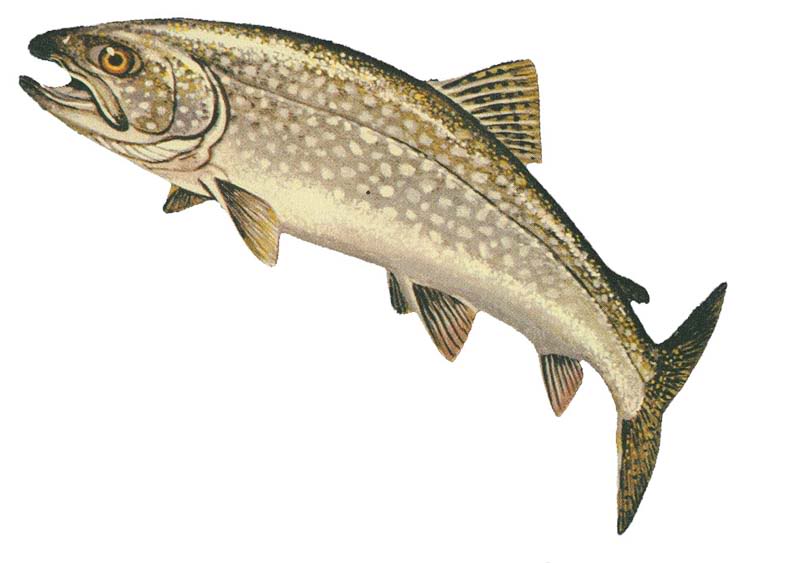
Last edited by saltfisher1 on Sat Feb 21, 2009 11:54 pm; edited 1 time in total | |
|   | | saltfisher1
Half-Dollar


Number of posts : 8362
Age : 52
Location : Alabama/Florida Gulf coast
Registration date : 2008-02-05
 |  Subject: Re: Trout Identification. Subject: Re: Trout Identification.  Sat Feb 21, 2009 11:45 pm Sat Feb 21, 2009 11:45 pm | |
| Chinook Salmon The Chinook salmon is blue-green on the back and top of the head with silvery sides and white ventral surfaces. It has black spots on its tail and the upper half of its body; its mouth is dark gray. Adult fish range in size from 33 to 36 inches (840 to 910 mm), but may be up to 58 inches (1.47 meters) in length; they average 10 to 50 pounds (4.54 to 22.7 kg), but may reach 130 pounds (59 kg). The current sport caught World Record is 97 pounds 4 ounces (44.1 kg) and was caught in May 1985 by Les Anderson in the Kenai River ( Kenai, Alaska). The commercial catch world record is 126 pounds (57 kg) caught near Petersburg, Alaska in a fish trap in 1949. [1 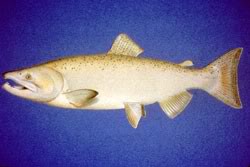
Last edited by saltfisher1 on Sat Feb 21, 2009 11:55 pm; edited 1 time in total | |
|   | | saltfisher1
Half-Dollar


Number of posts : 8362
Age : 52
Location : Alabama/Florida Gulf coast
Registration date : 2008-02-05
 |  Subject: Re: Trout Identification. Subject: Re: Trout Identification.  Sat Feb 21, 2009 11:48 pm Sat Feb 21, 2009 11:48 pm | |
| Coho Salmon Description During their ocean phase, Coho have silver sides and dark blue backs. During their spawning phase, the jaws and teeth of the coho become hooked, and they develop bright red sides, bluish green heads and backs, dark bellies with dark spots on their back. Sexually maturing coho develop a light pink or rose shading along the belly and the males may show a slight arching of the back. Mature coho salmon have a pronounced red skin color with darker backs and average 28 inches in length and seven to 11 pounds in weight, although coho weighing up to 36 pounds have been reported. Mature females may be darker than males, with both showing a pronounced hook on the nose. 
Last edited by saltfisher1 on Sat Feb 21, 2009 11:55 pm; edited 1 time in total | |
|   | | saltfisher1
Half-Dollar


Number of posts : 8362
Age : 52
Location : Alabama/Florida Gulf coast
Registration date : 2008-02-05
 |  Subject: Re: Trout Identification. Subject: Re: Trout Identification.  Sat Feb 21, 2009 11:49 pm Sat Feb 21, 2009 11:49 pm | |
| Pink Salmon Appearance In the ocean, pink salmon are bright silver fish. After returning to their spawning stream, their coloring changes to pale grey on the butt with yellowish white belly (although some turn an overall dull green color). As with all salmon, in addition to the dorsal fin they also have an adipose fin. The fish is characterized by a white mouth with black gums, no teeth on the tongue, large oval-shaped black spots on the back and v-shaped tail, and an anal fin with 13-17 soft rays. During their spawning migration, males develop a pronounced humped back, hence their nickname "humpies". Pink salmon average 4.8 pounds (2.2 kg) in weight. [1] The maximum recorded size was 30 inches (76 cm) and 15 pounds (6.8 kg). [2] 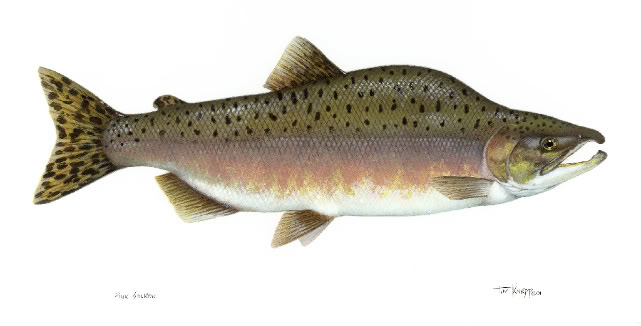 | |
|   | | North Star
Site owner


Number of posts : 12875
Age : 60
Location : Minnesota
Registration date : 2007-12-05
 |  Subject: Re: Trout Identification. Subject: Re: Trout Identification.  Sun Feb 22, 2009 8:00 am Sun Feb 22, 2009 8:00 am | |
| | |
|   | | Sponsored content
 |  Subject: Re: Trout Identification. Subject: Re: Trout Identification.  | |
| |
|   | | | | Trout Identification. |  |
|
Similar topics |  |
|
| | Permissions in this forum: | You cannot reply to topics in this forum
| |
| |
| |
|
